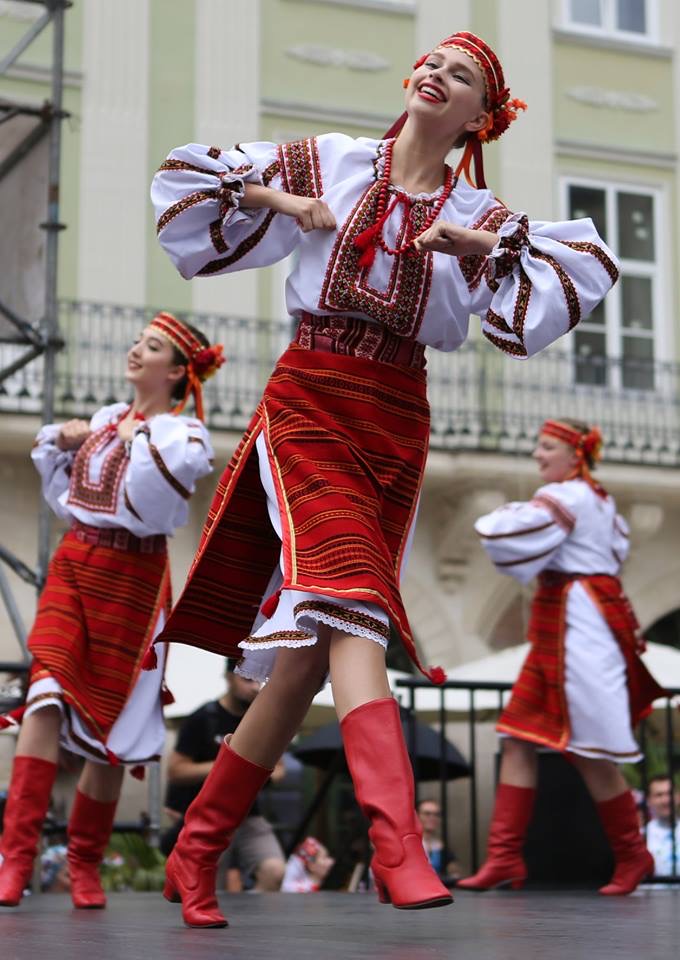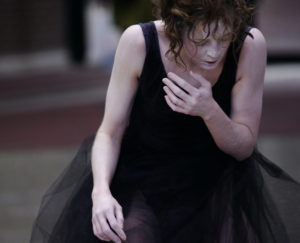Then, and Now: Ukrainian dance in Canada celebrates 130 years - Vancouver Ballet Society
- Home
- Features 2020 - 2023
- Then, and Now: Ukrainian dance in Canada celebrates 130 years

By Rebecca Karpus
Stealing from the rich and giving to the poor — it may sound like Robin Hood, but it is also the story of Oleksa Dovbush. Born in the Carpathian Mountains of Ukraine, Dovbush was known in the 18th century as a protector of the poor. Today, his legacy reminds the Dovbush Dancers of their socially progressive heritage and passion for spreading joy. The company is one of many Ukrainian dance ensembles in Canada celebrating 130 years of Ukrainian immigration in 2021.
Although the prairie provinces are most known for their considerable Ukrainian Canadian populations, there are other active communities throughout the country, including BC. In the heart of Strathcona, an east Vancouver neighbourhood, is a branch of the Association of United Ukrainian Canadians, where Dovbush Dancers is based. Debbie Karras, the company’s artistic director, shares that her grandmother became involved with the AUUC after immigrating to Canada in 1904, and Karras began learning Ukrainian dance there at a young age.

There are approximately 20 dancers in the group, many of whom are third and fourth generation Ukrainian Canadians. While Dovbush performs frequently for AUUC events, they have also participated in cultural festivals, weddings, the 2010 Olympic celebrations, local Nutcracker productions and the Vancouver Dance Centre’s Discover Dance noon-hour series.
Considering Dovbush’s avid community participation, it may appear that Ukrainian culture has been easily embraced as a part of Canadian life. However, the story is more complex. The first major wave of Ukrainian immigration to Canada began in the late 19th century and continued until the beginning of the First World War. At that time, immigration came to a halt as Ukrainians were registered as enemy aliens by the Canadian government. Because of Ukraine’s affiliation at the time with the Austro-Hungarian Empire, which Canada considered to be a threat, some Ukrainians were sent to internment and work camps around the country. It was not until years after the war ended that Ukrainian immigration flourished once again. Today, Canada has the third largest Ukrainian population in the world, behind only Ukraine itself and Russia. Through time, the country’s artistic landscape has become significantly impacted by Ukrainian culture, including dance.
Ukrainian dance can be broadly classified into three categories: ritual (based on ancient pagan traditions such as harvest and season solstice), social (national dances, such as the hopak) and thematic (portraying a specific theme or character and often incorporating props). Originally, these dances were enjoyed purely on a social basis, and it was only over time that Ukrainian stage dance began to take shape.

Despite the common image of men in red boots performing dazzling jumps, Ukrainian dance has numerous variations of style. Each region has developed their own specific steps, music and costumes, resulting in multiple distinctive identities within the art form. Today there are many contemporary touches, too. For example, some Ukrainian Canadian dancers wear fluorescent colours on their costumes, breaking from traditional attire, which was dyed only in colours found in nature.
Kristina Frykas, who directs Sopilka Ukrainian Dance School in Winnipeg, approves of adaptations as long as they do not disrespect or dilute the original. More importantly, whatever the adaptations, she feels strongly that Ukrainian dance needs to avoid coming across as kitschy or one-dimensional, and should be interpreted with depth and integrity.
Frykas and Karras both thank Vincent Rees, a Ukrainian Canadian former dancer, for providing the opportunity to learn straight from the source. His Cobblestone Freeway Tours connects Ukrainian Canadian dancers with experts in Ukraine, where they can learn a specific style in its place of origin, and be introduced to their heritage on a deeper level. Typically, real people are portrayed in Ukrainian dance, with their culture, geography, history and politics interwoven into the form’s artistic expression. With accessible cultural tours and the plethora of online resources available, as Karras says, there is really no excuse not to “get it right.”
Les Sereda, the senior creative director of Canada’s Ukrainian Shumka Dancers and a former dancer with the company, is an advocate of the form’s evolution. “We don’t live in a museum,” he remarks. Shumka, founded in Edmonton in 1959 and the country’s most high-profile Ukrainian dance ensemble, has maintained collaborative relationships with traditional titans like Virsky Ukrainian National Folk Dance Ensemble in Kyiv and the National Ballet of Ukraine, but it also endeavours to keep its work fresh and relevant. Sereda suggests that the term “traditional” may not hold the same meaning for everyone, and prefers to describe Shumka’s original style as “heritage,” which, he says, has since evolved as the company’s choreographers look to their “contemporary Canadian lives for continued inspiration” in the artistic process.

Using the lexicon of Ukrainian dance, Shumka productions often incorporate storylines as in classical ballet and integrate other dance influences, such as modern and jazz, if called for by the narrative. Past shows grappled with issues such as oppression and gender equality, and 2019’s Ancestors and Elders brought together Shumka, Edmonton’s Running Thunder Cree Dancers and other members of the local Indigenous community to tell the story of the evolving relationship between the region’s Indigenous peoples and the earliest Ukrainian Canadians. The production captured the beauty and intricacies of both cultures, but also touched on painful matters, such as residential schooling.
To continue the dialogue, Sereda directed a documentary titled Dancing on Eggshells, which explores the artistic process behind Ancestors and Elders, especially between the production’s directors, Joseph Hoffman, a former dancer with Shumka, and Indigenous theatre artist Barry Bilinsky, who has both Cree and Ukrainian heritage.
Ukrainian dance holds unique ties to other forms of dance. Virsky, for instance, refined Ukrainian folk dance for the stage by expanding its ballet vocabulary. According to Frykas, Pavlo Virsky’s company has set a standard for Ukrainian stage dance worldwide since its inception in 1937. Now, most Ukrainian dance classes begin with ballet exercises at the barre to develop the technique needed for footwork, jumps and turning sequences, but, in the choreography, there must be a balance between the ballet foundation and the Ukrainian character in order to maintain the form’s true essence.
Frykas is well versed in ballet, completing the teacher training program with the Royal Winnipeg Ballet School, and subsequently teaching Cecchetti syllabus and character dance there. She considers her Ukrainian dance experience an asset to her ballet pedagogy. Firstly, the complex footwork in Ukrainian dance has provided her with a sophisticated sense of rhythm, which, she says, contributes to her students’ musicality, especially in allegro sequences. Second, Ukrainian dance often integrates expressive shoulder coordination and postures of the upper body, which gives Frykas a fuller understanding of ballet’s épaulement. Lastly, although most ballet students do not begin pas de deux training until their teenage years, Ukrainian dancers begin partner work at a young age. From their first days in class, boys and girls are taught to move together as one, learning how to lead, follow and connect with each other. This experience has allowed Frykas to better understand the complexities of partner work, and to pass this on to her ballet students. Qualities and skills specific to Ukrainian dance have entered Frykas’ ballet pedagogy, creating a unique and engaging environment for her students.

Former Royal Winnipeg Ballet principal dancer Dmitri Dovgoselets, born in Ukraine, was accepted to train with the National Ballet School of Ukraine at the age of ten. Previously, students at the school were divided into two streams: ballet or Ukrainian dance, the former often feeding into the National Ballet of Ukraine, and the latter to Virsky. However, Dovgoselets and his fellow students were trained in both. A strong foundation in Ukrainian dance was essential, as the school was affiliated with the National Opera of Ukraine, which often had Ukrainian dance roles in their productions. With both styles under his belt upon graduation, Dovgoselets began his career in ballet when hired by the National Ballet of Ukraine. After dancing with the company for two years, he travelled to Canada to tour with Shumka and, soon after, joined the Royal Winnipeg Ballet.
Dovgoselets believes there is something about the training and specificity of Ukrainian dance that provides a bolder, more confident stage presence compared to those only trained in ballet: Ukrainian dance teaches students that it is always their “time to shine.” Throughout his ballet career, Dovgoselets managed to carve out time to teach Ukrainian dance in the community.

For Molly McDermott, a Vancouver-based contemporary dancer of Ukrainian descent, Ukrainian dance was her first form, and she was introduced to contemporary in university. Not only does McDermott feel that Ukrainian dance contributed to the stamina and discipline required for her professional contemporary dance career, she also notes some crossover between certain steps. While learning Ukrainian dance in her youth, McDermott admired the exciting acrobatic choreography often performed by boys and men, and began practicing some of the more grounded tricks on the sidelines. She finds a link between these movements and contemporary floor work, believing her body was already familiar with certain floorwork patterns due to this experience in Ukrainian men’s work.
McDermott says her exposure to Ukrainian dance has also influenced her taste in dance. She is drawn to contemporary work that possesses significant physicality and a visceral quality, yearning for the emotional impact that Ukrainian dance brings to her on a personal level. “There’s an energy you can count on with Ukrainian dance,” she says.
When it comes to acknowledging the 130th anniversary of Ukrainians in Canada, Dovbush Dancers’ Karras reflects on the necessity of passing down stories through generations. Like the tales by which Oleksa Dovbush is remembered, the histories of immigrants can only remain relevant and alive if shared. Ukrainian dance is one way to do that — like every twist and turn in a story’s development, every spin, jump and step in a choreography brings one closer to those who have come before and paved the way for today.

